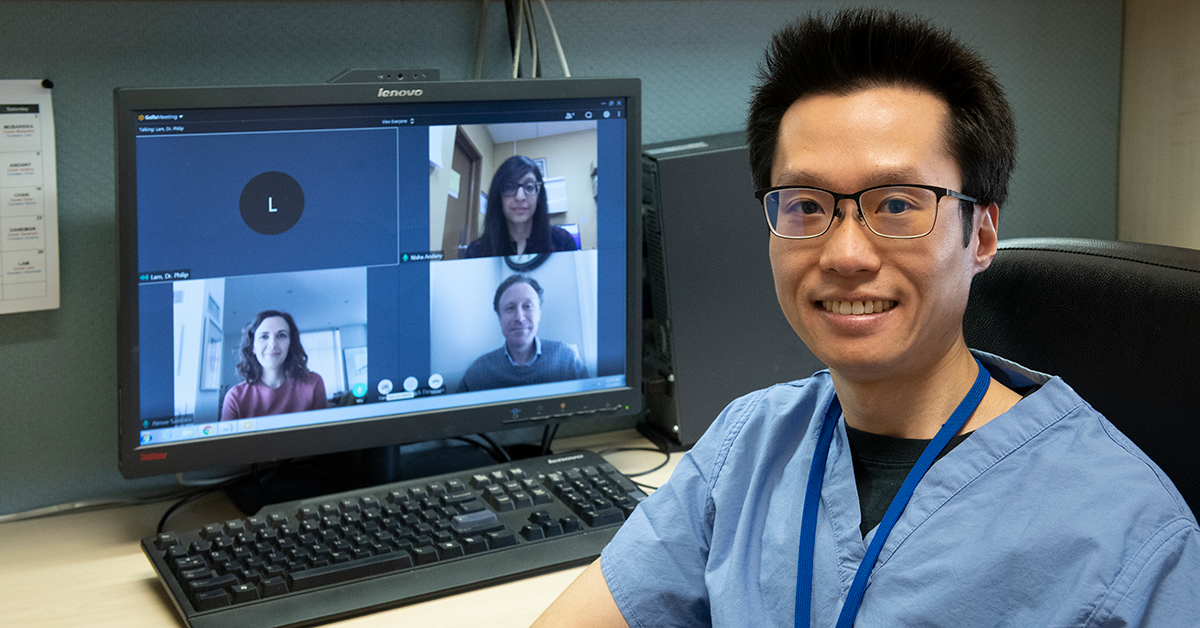Sunnybrook patients recovering at home from COVID-19 get advice, support from new virtual program
A new program is helping Sunnybrook patients with COVID-19 who have mild to moderate symptoms manage their recoveries at home, providing support and a care plan by phone or video.
“We created COVIDEO because we didn’t want to notify our patients at home that they’ve tested positive for COVID-19, and then abandon them. It’s important that they still have access to a support system,” says Dr. Nick Daneman, an infectious diseases physician at Sunnybrook. He is co-leading the project with Drs. Philip Lam, Nisha Andany and Adrienne Chan, all of whom are also infectious diseases physicians at Sunnybrook.
“Some patients can be quite sick at the time they are diagnosed, but they don’t necessarily need to be admitted to the hospital. Often, they are self-isolating and recovering at home by the time they receive a positive COVID-19 test result,” says co-lead Dr. Chan.
It’s at that point that Sunnybrook’s infectious diseases (ID) team is informed of the diagnosis, and the patient joins COVIDEO as an outpatient. An ID physician will initiate a virtual care visit, either by phone or video. Scheduled visits continue at regular intervals, sometimes daily, until the patient either recovers or deteriorates enough to require admission to the hospital.
“The COVIDEO program gives our patients a therapeutic presence, reassurance, supportive care strategies, a monitoring plan and a point of contact for emergencies. It also allows for a safe way to bring in the minority that require admission to the hospital,” says Dr. Daneman.
As part of the COVIDEO program, patients and their caregivers also have access to the ID physician on call 24/7, and are encouraged to call when they have any questions or concerns.
That 24/7 support proved to be an essential feature for Jackie,* whose husband Tom* joined the outpatient COVIDEO program in late March after being diagnosed with COVID-19. While monitoring his oxygen levels at home one night with a personal sat monitor, she got a reading low enough that she was concerned Tom needed to go to the emergency department.
“Thankfully, I was able to get Dr. Andany on the phone within a few minutes to get her advice. She didn’t like how low the reading was either, so she recommended I call an ambulance to have them double check his oxygen levels with their equipment,” says Jackie.
After the paramedics arrived, they confirmed it was a false alarm — the personal monitoring machine she had purchased was giving an incorrect reading, and Tom’s oxygen level was actually within the normal range.
“I discussed the situation with the paramedics over the phone after they arrived. Initially, I was concerned that Tom would need to come to hospital quickly based on the low reading. However, once it was confirmed that it was an equipment issue and not a matter of dangerously low oxygen levels, we were able to tell the patient it was safe for him to stay home rather than make the trip to the emergency department,” says co-lead Dr. Andany.
That was also an important learning experience for the team in the early days of the program.
“Now, we send mini-oxygen saturation monitors to patients that they can use at home, to make sure they’re always getting an accurate reading,” says co-lead Dr. Lam.
After conducting the first COVIDEO appointment at the end of February, the team has now assessed more than 200 patients. Nearly all of them have been cared for in the community without requiring admission to hospital. Other hospitals have already expressed interest in creating similar programs using Sunnybrook’s model.
Tom was recently declared free of COVID-19 infection, and Jackie remains grateful that an ID physician checked in on her and her husband nearly every day during their time in the COVIDEO program.
“Just knowing that there was always someone I could reach gave me a sense of security. It was really nice that someone was there to hold my hand through this whole process.”
*names changed at the patient’s request
Media contact
Sybil Millar
Communications advisor
sybil.millar@sunnybrook.ca



